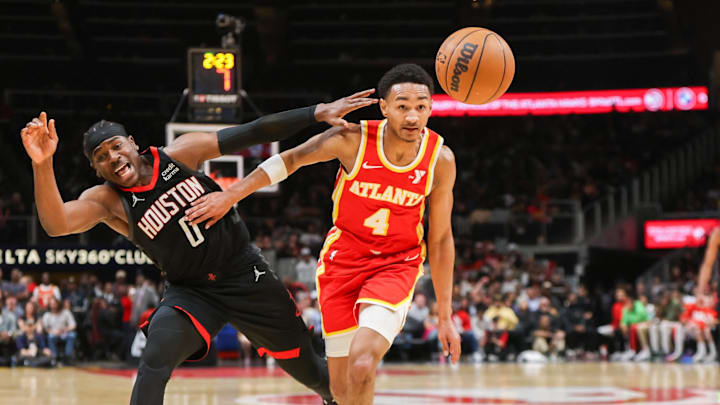Hawks’ former first round pick Kobe Bufkin has struggled in his short NBA career. It is not fair to judge the third-year player too harshly, as he has only played in 27 games after a series of injuries. However, Bufkin has not suffered the typical recurring injuries, indicating he should be able to log serious playing time this season. With a full NBA season on a significantly revamped roster, Bufkin has to prove he is capable of filling the backup point guard spot or risks being shipped at the trade deadline.
Hawks’ GM Onsi Saleh has made a critical change to the Atlanta Hawks’ identity: there are no non-shooters in the rotation. After trading Clint Capela to the Houston Rockets in a record-breaking trade, the Hawks have a team where every player expected to play significant minutes can space the floor.
A second underrated aspect of Atlanta’s offseason that will aid Bufkin is the acquisition of Luke Kennard, who has excellent synergy with Bufkin. Mostly known for his lights-out three point ability, Kennard ‘s playmaking ability is an underrated strength of his that will aid Bufkin in the bench unit.
Bufkin’s path to being a productive player looks much easier
While the Hawks have two remaining roster spots, it seems unlikely they will add an experienced point guard this offseason given the lack of free agent talent and proven trade pieces remaining. This leaves Bufkin as the presumed backup point guard in Atlanta.
Bufkin is a combo guard who fits the Dejounte Murray archetype of NBA player. A 6’5 guard with a 6’8 wingspan and crafty offensive game, Bufkin was drafted with the goal of supporting Trae Young’s weak defense, but the Hawks ultimately found their backcourt partner for Young in Dyson Daniels. His defense and positional size could make the Hawks’ bench one of the best defensive bench units in the league when paired with Nickel Alexander-Walker and Onyeka Okongwu.
The potential problems with Bufkin lie on the offensive end of the court. He has not proven he is a three point threat, nor has he shown the chops to deserve a backup point guard spot on a contending team. The removal of Capela and addition of Kennard will soften the negative effects of these weaknesses on this year’s Hawks team.
Playing someone like Capela, who poses absolutely no threat from beyond the paint, allows defenses to keep their best rim protector near the rim, which has negative externalities on the rest of the team. This harms Bufkin more than others as his offensive strengths lie inside the paint, yet he does not possess the length to challenge big men at the rim.
With the improved spacing, Bufkin’s slashing and ability to operate in the pick and roll become much more dangerous weapons than before, where he often shared the court with Capela. This is apparent in summer league, where Bufkin has shown an impressive ability to generate open looks off the pick and roll for himself and his teammates (even if these looks aren’t falling).
The addition of Kennard takes the pressure of backup offensive initiator off Bufkin’s shoulders. While his playmaking has impressed in the 2025 NBA Summer League, Bufkin has not shown this is a true strength of his against NBA competition. With Kennard, however, now Bufkin can split reps as the lead playmaker. This may seem like a minor change, but it frees up Bufkin to work off the ball and forces defenses to choose between guarding Bufkin or Kennard with their best bench defender.
There’s no denying that Bufkin still has to prove he deserves his spot in the Hawks’ rotation. However, Bufkin’s life has become much easier after Atlanta’s home-run offseason.
